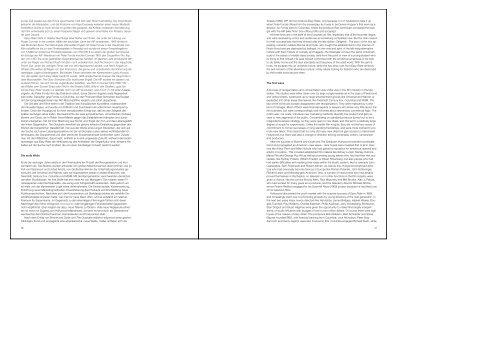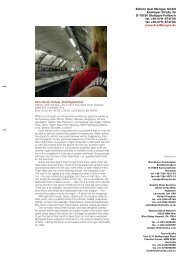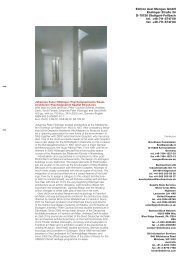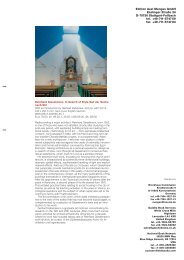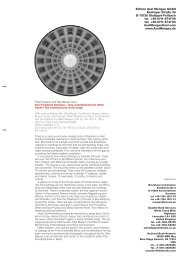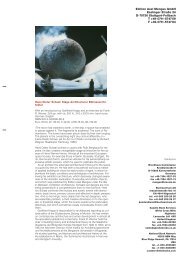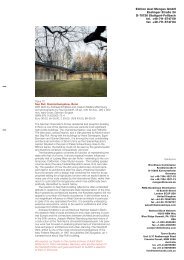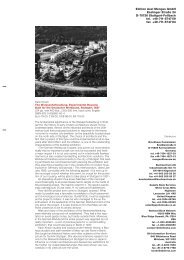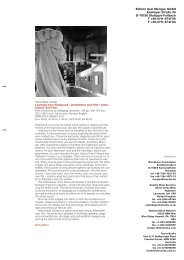New Hollywood - Edition Axel Menges
New Hollywood - Edition Axel Menges
New Hollywood - Edition Axel Menges
Erfolgreiche ePaper selbst erstellen
Machen Sie aus Ihren PDF Publikationen ein blätterbares Flipbook mit unserer einzigartigen Google optimierten e-Paper Software.
kurzer Zeit wieder aus den Kinos verschwand, hielt sich sein Ruhm hartnäckig. Der Soundtrack<br />
erklomm die Hitparaden, und die Kostüme von Faye Dunaway kreierten einen neuen Modestil.<br />
Schließlich wurde er noch einmal im großen Stil gestartet, die Kritiker revidierten ihre Meinung,<br />
der Film entwickelte sich zu einem Kassenschlager und gewann eine Reihe von Preisen, darunter<br />
zwei Oscars.<br />
Easy Rider steht in direkter Nachfolge einer Reihe von Filmen, die unter der Leitung von<br />
Roger Corman in der zweiten Hälfte der sechziger Jahre bei AIP entstanden. 1966 drehte er<br />
das Motorrad-Epos The Wild Angels (Die wilden Engel) mit Peter Fonda in der Hauptrolle. Der<br />
Film schaffte es bis zu den Filmfestspielen in Venedig und wurde mit einem Einspielergebnis<br />
von 5 Millionen Dollar bei Produktionskosten von 350 000 $ zu einem der großen kommerziellen<br />
Erfolge der AIP. Wiederum mit Peter Fonda machte Corman 1967 den Drogenfilm The Trip,<br />
der vom LSD-Trip eines gestreßten Geschäftsmannes handelt. Im gleichen Jahr produzierte AIP<br />
unter der Regie von Richard Rush mit dem noch unbekannten Jack Nicholson in der Hauptrolle<br />
Psych Out, einen der wenigen Filme, der von der Hippieszene handelt, und Hell’s Angels on<br />
Wheels (Die wilden Schläger von San Francisco), die genau und unprätentiös die Stimmung der<br />
damaligen Jugend wiedergeben. Bei beiden Filmen arbeitete der Kameramann Lazlo Kovacs<br />
mit, der später durch Easy Rider berühmt wurde. 1968 spielte Dennis Hopper die Hauptrolle in<br />
dem Motorradfilm The Glory Stompers (Die teuflischen Engel). Die AIP erzielte mit diesen und<br />
anderen Filmen, die sich mit der Jugendkultur befaßten, wie Riot on Sunset Strip (1967, Wir ...<br />
die Wilden vom Sunset Strip) oder Wild in the Streets (1968, Wild in den Straßen), gute Gewinne.<br />
Easy Rider wurde nur deshalb nicht von AIP produziert, weil Arkoff (?) mit einer Zusage<br />
zögerte, als Peter Fonda ihm das Drehbuch anbot, da es Dennis Hoppers erste Regiearbeit<br />
sein sollte. Daraufhin ging Fonda zu Columbia, wo der Produzent Bert Schneider das Budget<br />
mit den Einspielergebnissen der AIP-Motorradfilme verglich und sofort akzeptierte.<br />
Der Stil aller drei Filme steht in der Tradition des europäischen Kunstfilms, insbesondere<br />
der Nouvelle Vague, und wurde von Kritikern und Zuschauern als vollkommen neuartig empfunden.<br />
Doch der Hauptgrund für ihren sensationellen Erfolg war, daß sie den Zeitgeist der<br />
späten sechziger Jahre trafen. Die Geschichte der zwei sympathischen, romantischen Outlaws<br />
Bonnie und Clyde, die in Robin-Hood-Manier gegen das Establishment kämpfen und durch<br />
Verrat untergehen, traf mit ihrer Mischung aus Komik und Tragik den Ton und das Lebensgefühl<br />
der linken Gegenkultur. The Graduate vermittelt die gleiche kritische Einstellung gegenüber den<br />
Werten der bürgerlichen Gesellschaft, hier aus der Warte eines jungen Studenten, der sich auf<br />
der Suche nach einer Lebensperspektive mit der emotionalen Leere seines wohlhabenden Elternhauses,<br />
der Doppelmoral und dem Verrat der Erwachsenenwelt konfrontiert sieht. Zusammen<br />
mit dem Mädchen, das er liebt, entflieht er in eine ungewisse Zukunft, während die beiden<br />
Aussteiger aus Easy Rider die Verkörperung des Antihelden der Gegenkultur sind: einsame Rebellen<br />
auf der Suche nach Freiheit, die von einer feindseligen Umwelt zerstört werden.<br />
Die erste Welle<br />
Ende der sechziger Jahre setzte in der Filmindustrie ein Prozeß der Reorganisation und Konzentration<br />
ein. Die Studios wurden entweder von großen Mischkonzernen übernommen, wie im<br />
Fall von Paramount und United Artists, von Großunternehmen der Unterhaltungsindustrie geschluckt,<br />
wie Universal und Warner, oder sie expandierten selbst in andere Branchen, wie<br />
Twentieth Century Fox, Columbia und MGM. Mit der Reorganisation verschwanden die letzten<br />
der alten Studiobosse. An ihre Stelle trat eine neue Art von Managern. Die meisten waren Finanzexperten<br />
oder Rechtsanwälte, die wenig vom Filmgeschäft verstanden, dafür jedoch um<br />
so mehr von der elementaren Logik eines Unternehmens. Die Devise lautete: Kostensenkung,<br />
Einführung neuer Marketingmethoden, Diversifizierung des Produkts und Erschließung neuer<br />
Publikumsschichten. Nachdem sich die Konzentration auf Standardprodukte als verfehlte Geschäftsstrategie<br />
erwiesen hatte, war man für neue Ideen offen, und es entstand ein relativer<br />
Freiraum für Experimente. Im Gegensatz zu den ehemaligen Filmmoguln fühlten sich deren<br />
Nachfolger den früher erfolgreich Gewesenen oder langjährigen Freundschaften gegenüber<br />
nicht verpflichtet. Eher neigten sie dazu, neue Talente zu fördern. Viele neue Regisseure erhielten<br />
so nicht nur Zugang zum <strong>Hollywood</strong>-Mainstream, sondern es fand auch ein Generationswechsel<br />
bei den Drehbuchautoren, Kameraleuten und Produzenten statt.<br />
Nach dem Erfolg von Bonnie and Clyde und The Graduate witterte <strong>Hollywood</strong> einen gewinnträchtigen<br />
Trend und propagierte eine amerikanische »neue Welle«. Dabei richteten sich die<br />
16<br />
Streets (1968). AIP did not produce Easy Rider, only because Arkoff hesitated to take it up<br />
when Peter Fonda offered him the screenplay, as it was to be Dennis Hopper's first work as a<br />
director. So Fonda went to Columbia, where the producer Bert Schneider compared the budget<br />
with the AIP biker films' box-office profits and accepted.<br />
All three films are in the style of the European art film, especially that of the Nouvelle Vague,<br />
and were received by critics and audiences as something completely new. But the main reason<br />
for their success was that they chimed with the late sixties »Zeitgeist«. The story of the two appealing,<br />
romantic outlaws Bonnie and Clyde, who fought the establishment in the manner of<br />
Robin Hood and are destroyed by betrayal, hit the tone and spirit of the left-wing alternative<br />
culture with their mixture of comedy and tragedy. The Graduate conveys the same critical attitude<br />
to the values of middle-class society, here from the point of view of a young student who<br />
iis trying to find himself. He sees himself confronted with the emotional emptiness of his wellto-do<br />
family home and the dual standards and treachery of the adult world. With the girl he<br />
loves, he escapes into an uncertain future, while the two drop-outs from Easy Rider embody<br />
the anti-heroism of the alternative culture: lonely rebels looking for freedom who are destroyed<br />
by the hostile world around them.<br />
The first wave<br />
A process of reorganization and concentration was under way in the film industry in the late<br />
sixties. The studios were either taken over by large conglomerates as in the case of Paramount<br />
and United Artists, swallowed up by large entertainment groups like Universal and Warner, or<br />
expanded into other areas themselves, like Twentieth Century Fox, Columbia and MGM. The<br />
last of the old studio bosses disappeared with reorganization. They were replaced by a new<br />
kind of manager. Most of them were financial experts or lawyers who knew very little about the<br />
film business, but were correspondingly well informed about elementary commercial logic. The<br />
motto was: cut costs, introduce new marketing methods, diversify the product and gain access<br />
to new segments of the public. Concentrating on standard products turned out to be a<br />
misguided business strategy, so they were open to new ideas, and this led to a relatively large<br />
degree of scope for experiments. Unlike the earlier film moguls, they did not feel any sense of<br />
commitment to former successes or long-standing friendships, and were more inclined to promote<br />
new talent. This meant that not only did many new directors gain access to mainstream<br />
<strong>Hollywood</strong>, but there was also a change of direction among screenplay writers, cameramen<br />
and producers.<br />
After the success of Bonnie and Clyde and The Graduate, <strong>Hollywood</strong> scented a profitable<br />
trend and propagated an American »new wave«. Here hopes were invested first of all in directors<br />
like Arthur Penn and Mike Nichols who had gained a reputation for ambitious material and<br />
artistic innovation. This included established film-makers like Sidney Lumet, Stanley Kubrick,<br />
Martin Ritt and George Roy Hill as well as promising young talents who had had their first successes,<br />
like Sydney Pollack, William Friedkin or Stuart Rosenberg, but also people who had<br />
had earlier difficulties with realizing their ideas within the studio system, like for example John<br />
Cassavetes, Sam Peckinpah and Robert Altman. As well as this, <strong>Hollywood</strong> employed directors<br />
who had previously become famous in Europe like Roman Polanski, John Schlesinger,<br />
Richard Lester and Michelangelo Antonioni. Also, a number of newcomers who had already<br />
proved themselves in the theatre, on television or in other functions in the film industry were<br />
given a chance, like the comics Woody Allen, Paul Mazursky and Mel Brooks, Alan J. Pakula,<br />
who had worked for many years as a producer, and the television director Michael Ritchie,<br />
whom Robert Redford engaged for his Downhill Racer (1969) project because he had liked one<br />
of his television films.<br />
<strong>Hollywood</strong> discovered the youth market with the surprise success of Easy Rider in 1969,<br />
and increasingly went over to promoting projects by young directors of the next generation. In<br />
the next two years many novice directors like Hal Ashby, James Bridges, Haskell Wexler, Douglas<br />
Trumbell, Paul Williams, Charles Eastman, Philip Kaufman, Jerry Schatzberg, Bill Norton,<br />
Stan Dragoti and Stuart Hagman were given the opportunity to make films largely independently<br />
of studio influence with budgets of one to two million dollars. Of course there were high<br />
hopes of the makers of Easy Rider. The producers Bob Rafelson, Bert Schneider and Steve<br />
Blauner founded BBS, with financial backing from Columbia; Jack Nicholson, Peter Bogdanovich<br />
and Henry Jaglom were also involved in this. Columbia engaged Richard Rush, while<br />
17


